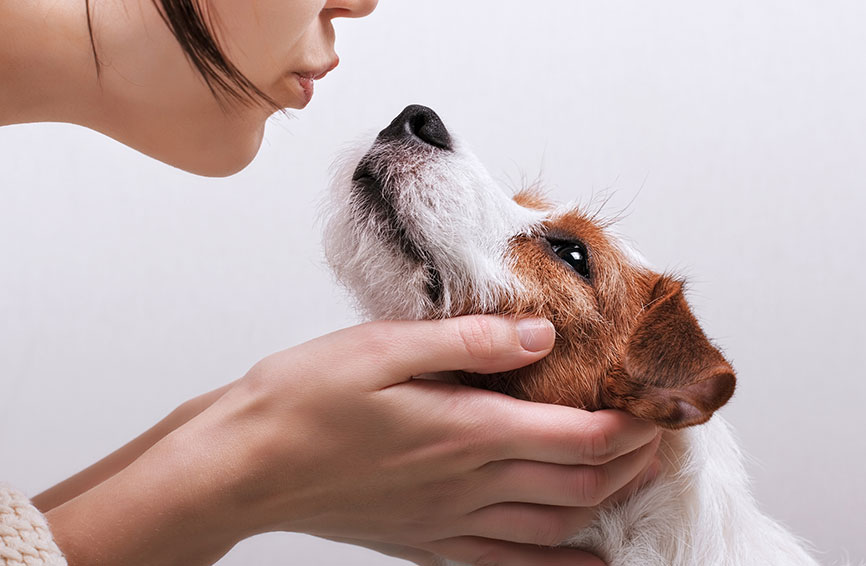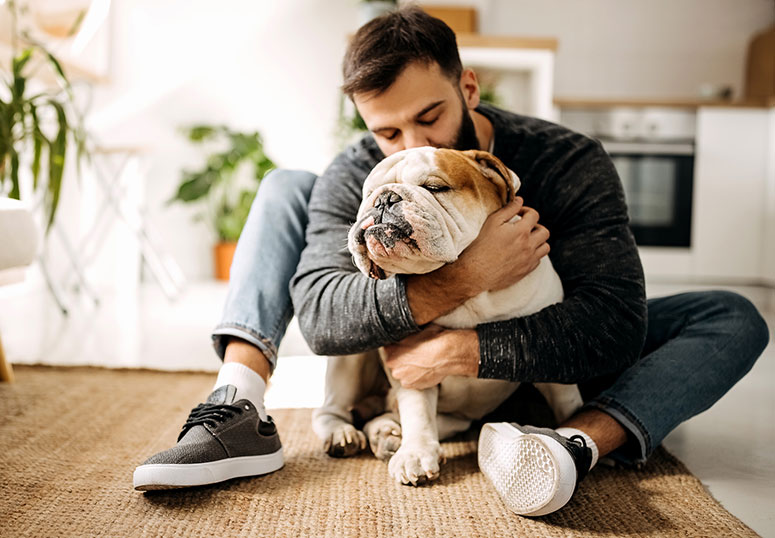Key Takeaways
- It is possible for a puppy to develop a mother-like bond with a human.
- Dogs have an advanced sense of smell that contributes to human recognition and they can observe human facial expressions.
- Positive reinforcement and socialization with people and dogs affect a dog’s preferences.
Table of Contents
Many believe a healthy puppy-parent relationship has less to do with biology than socialization. So, yes, a puppy can think of you as his “mother” — his provider and protector — and develop as strong an emotional bond with you as if you were blood-related.
Your puppy will also quickly learn to pick you out among strangers, both by sight and through his powerful sense of smell. However, developing healthy interactions and ensuring your pup recognizes you as his loving pet parent requires some nurturing.
The science behind dog-human relationships
It’s all about the nose
With 220 million receptors compared to the 5 million humans have, a dog’s sense of smell is 10,000 to 100,000 times more sensitive than human senses, according to canine researcher James Walker. Regarding human recognition, dogs can decipher one individual’s odor-causing secretions from another’s. In addition, dogs possess a pheromone at the base of the nasal passage, providing species and sex information. Mom’s scent will be found on her skin, clothes, house, car and bed, providing a constant stream of information for Fido to use.
And the eyes…
Canine eyesight has been thoroughly studied, and it seems domestication has made dogs much more aware of human facial expressions. In 2016, Outi Vainio, DVM, of the University of Helsinki, discovered that dogs held their gaze on their owners’ eyes longer than on others when shown images of humans. Paolo Mongillo, of the University of Padua in Italy reinforced these findings. In his study, published in the journal Animal Behaviour, a dog gazed at his owner, walking across a room significantly longer than a stranger. To ensure this was due to sight rather than smell, researchers asked human participants to walk across a room wearing paper bags to conceal their faces; this time, the dogs were much less interested.
Nature versus nurture
Behavior may play an important role in letting Spot know who his pet parent is. Historically, dogs lived as packs with a reliable, strong, dependable leader. The VCA Animal Hospital says the human-animal bond is not based on a battle for dominance. Several factors, including genetics, learning and conflict resolution, create the bond. VCA asserts that positive reinforcement, socialization with other people and dogs, and consistency in training develop a much stronger, healthier and lasting bond between dogs and their human families.
In the book “Dog Is Love,” animal behaviorist Clive D.L. Wynne presents dozens of studies and observations about why and how dogs love us.
- The human-dog bond goes down to the neurochemical level, citing a study at Emory University where dogs’ brains were scanned in an MRI machine. Most of the dogs showed more brain activation by receiving praise from their special humans than by food.
- Another study shows an elevation in dopamine levels, a feel-good hormone, in dogs and humans when they interact.
Building a strong relationship with your dog
Of course, ensuring your dog sees you as his loving pet parent takes more than just them smelling or seeing you. The type of interactions you have with your dog will largely determine whether they see you as a family member who will protect them.
The best way to bond is simply to spend time with your dog and treat them like the amazing, unique, lovable best friend that they are. Bonding occurs naturally between dogs and the people who treat them well. Take good care of your dog, and they’ll reward you with a lifetime of love. Try to spend at least 30 minutes of focused, one-on-one time together each day.
Spending time together can take many forms. They include:
- Attention and care: This is the basic building block of a bond. Attending to your dog by feeding them, looking at them, and praising them shows that you care. “Dogs are intelligent beings much more in tune with their feelings and ours than most people realize. Dogs have an innate desire to feel acknowledged and loved and need to know they are a valued part of the family to feel happy and content,” said Sarah-Anne Reed, a dog training consultant for Healthy Paws.
- Affection: Dogs vary in their desire for affection, but most will at least appreciate a head pet and a butt scratch. Other dogs want to be near their pet parents as much as possible. Read your dog’s cues on how much touching they want.
- Safety: It’s vital that your dog feels safe with you. This happens when you use positive reinforcement training techniques (no harsh punishment), show them you are the leader, and keep them out of situations where they will be anxious.
- Walking your dog, or other exercise such as swimming, is probably their favorite activity and will improve the bond between you. A daily walk is essential for their mental and physical health and for learning to socialize with other dogs and people.
- Training: Working on new skills, or reinforcing old ones, is a great way to bond. Dogs love structure and learning.
- Try a sport like agility or fly ball where you and your dog can work together as a team.
- Food (in healthy, appropriate quantities) is love! Aim for wholesome protein sources with limited fillers, and try some homemade meals for your dog. Make mealtime a bonding activity by integrating eye contact.
- Spa day: Give your dog a grooming session or massage.
- Play fetch, tug, or hide and seek. Mix it up with twists on classic toys to keep their interest.
How to know if your dog is bonded to you
From eye contact to greetings, this is how you’ll know if your dog is bonded to you, according to Rover. When they’re attached to you, dogs:
- Make eye contact: In the world at large, eye contact can be seen as a challenge, but in loving relationships, it’s a sign of trust and love.
- Check-in with you: Dogs bonded to their people often look at them. Even the most adventurous, independent dogs typically show their connection by “checking in.”
- Are happy to see you: A happy, noisy, tail-waggy greeting when you come home is one of the surest signs you and your dog are connected.
- Are relaxed with you: A bonded dog is also a comfortable dog. Relaxed body language includes open mouth with a lolling tongue, tail wagging, and rolling over for belly rubs.
- Snuggle your stuff: Dogs who are attached to their owners are also very attached to their scent and may snuggle up with their belongings.
- Listen and respond to you: Responsiveness is one of the most significant signs that you and your dog have formed a strong bond.
- Seek out your affection: If your dog seeks out pets, leans, snuggles, and even hugs, it’s a sure sign they’re bonded to you.
The secure base effect
In human psychology, a concept called “secure base attachment” means that infants need a secure dependence on their primary caregivers through a safe, reliable relationship before they can explore unfamiliar situations. This “secure base” effect allows infants to learn about the environment and, ultimately, to become self-reliant, independent adults.
A 2021 study published in Plos One found that dogs are also prone to use a “secure base,” following many of the same patterns of an infant-human bond. Just like infants, dogs seek out their pet parent in new or stressful situations, show distress when separated from you, and explore their environment more with you than alone.
If your dog treats you as their “secure base,” they likely see you as their parent or protector.
You’ll know when Fido accepts you as mom
Over time, your puppy will utilize his instincts and learned behaviors from interactions with you and ultimately recognize you as mom. Enrolling him in puppy training will help you and him develop positive interactions and expectations. A veterinarian can point you in the right direction and determine whether one-on-one training or puppy classes would be most beneficial for your new addition. Also, while your dog is young, is the best time to enroll them in puppy insurance.
Want to learn more about your pup? Check out Does My Dog Know My Name?, How Far Away Can a Dog Detect Scent?, and Does My Dog Have a Vision Problem? at Cuteness.com.
This article is provided by Cuteness—the go-to destination for passionate pet parents. Cuteness has answers to all of your health, training, and behavior questions – as well as the cutest, funniest, and most inspiring pet stories from all over the world.










